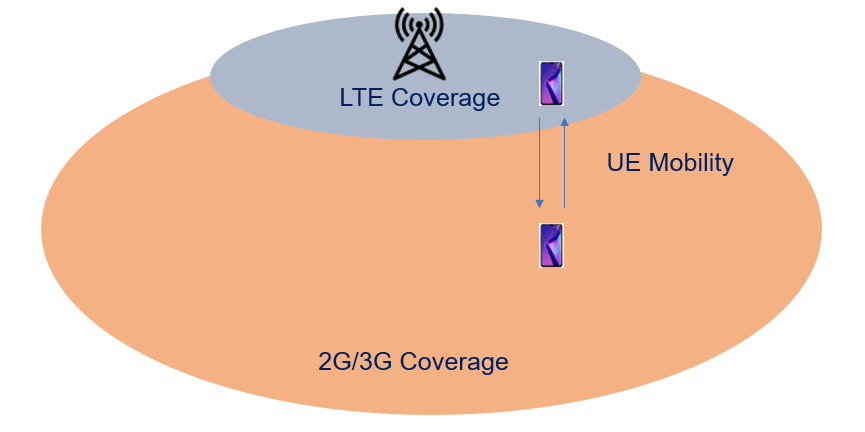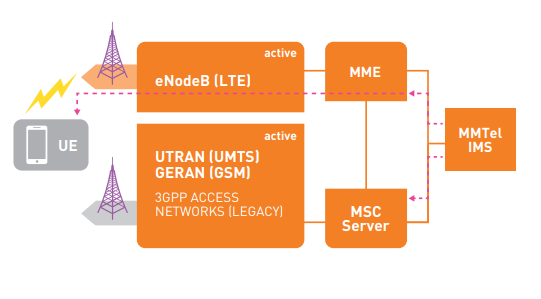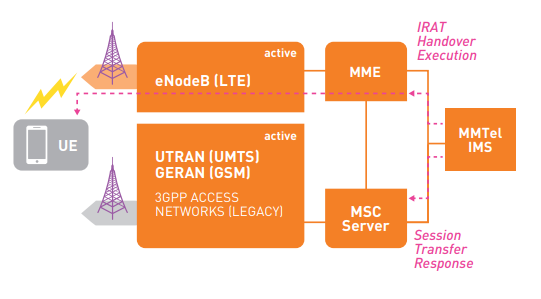SRVCC -Single Radio Voice Call Continuity
SRVCC
SRVCC is Single Radio Voice Call Continuity, It is 4G network feature that allows ongoing voice calls to be seamlessly transferred between 4G and 2G/3G Radio Access Networks. SRVCC feature is required for 4G VoLTE networks which do not continuous RF Coverage and coverage gaps are filled with 2G/3G RF coverage .

We can see above picture for example, where we have 2G/3G cell having a wider coverage and 4G Cells with small coverage foot prints. When a UE moves from one 4G cell to another 4G cell due to no-overlap 4G coverage UE has to go through 2G/3G Coverage. So When UE is in Voice Call session and moving though 4G and 3G/2G Coverage it needs to have Voice Continuity for good user experience.
So with SRVCC feature enable UE can be easily handover from 4G Cell to 2G/3G Cell and Voice call session will continue and User will not notice and interruption. UE may observe it is a single cell with allowing the Voice Continuity.
SRVCC Evolution
- 3GPP Release 8
- Basic SRVCC – Call Continuity from E-UTRAN to UTRAN/GRAN
- 3GPP Release 10
- aSRVCC – Packet switched to Circuit Switched call transfer during Alerting Phase
- eSRVCC – Enhanced SRVCC with support of MSC Server assisted Mid Call Feature
- 3GPP Release 11
- vSRVCC – supporting Video Call Continuity
- rSRVCC – SRVCC from UTRAN/GRAN to E-UTRAN
SRVCC Benefits
- SRVCC solution transfers VoLTE calls in progress from LTE to legacy voice networks, while maintaining the QoS requirements
- SRVCC by ensuring voice call continuity satisfies critical requirements for emergency calls
- Without SRVCC, operators with gaps or weaknesses in LTE coverage (or offering roaming in non-LTE networks) cannot realize the user experience and network efficiency
- With SRVCC, operators can accelerate time to market and realize these benefits during the entire time span from today’s hybrid network environments
- Operator can get more ROI from Legacy 2G/3G Network but offloading some traffic
- SRVCC supports both Packet Switching (PS) and Circuit Switching (CS)
SRVCC Network Architecture
Starting from 3GPP Release 8, SRVCC has evolved continuously. To ensure interoperability of implementations with legacy networks, the GSMA has provided a set of guidelines for SRVCC detailing the requirements for networks and user devices.
SRVCC provides continuity for PS to CS handover between LTE and WCDMA/GSM networks and from LTE to CDMA networks. GSMA guidelines recommend 3GPP Release 10 architecture for SRVCC, because it reduces both voice interruption delay during handover and the dropped call rate compared with earlier configurations.

The network controls and guides the user device from LTE to 2G/3G as the user moves out of LTE coverage. The SRVCC handover mechanism is fully network controlled and calls remain under control of the IMS core network, which maintains access to subscribed services implemented in the IMS/MMTel service engine before, during and after the handover.
The Release 10 configuration includes all components needed to manage the time-critical signaling between the user’s device and the network, and between network elements within the serving network, including visited networks during roaming. As a result, signaling follows
the shortest possible path and is as robust as possible, minimizing voice interruption time caused by switching from the PS core to the CS core, whether the user’s device is in its home network or roaming.
How SRVCC Works
The SRVCC enables the controls the transfer of calls in both directions from 4G to 2G/3G and 2G/3Gto 4G. Handover from 4G to the legacy network is required when the user moves out of the 4G RF coverage. SRVCC HO happens in two steps
- Inter RAT Handover
- Session transfer

During the handover process the CSCF within the IMS architecture maintains the control of the whole operation. Voice handover using SRVCC on LTE
The SRVCC handover process takes place in a number of steps:
- The handover process is initiated by a request for session transfer from the IMS CSCF.
- The IMS CSCF responds simultaneously with two commands, one to the LTE network, and the other to the legacy network.
- the LTE network receives a radio Access Network handover execution command through the MME and LTE RAN. This instructs the user device to prepare to move to a circuit switched network for the voice call.
- The destination legacy circuit switched network receives a session transfer response preparing it to accept the call from the LTE network.
- After all the commands have been executed and acknowledged the call is switched to the legacy network with the IMS CSCF still in control of the call.
Legacy network to LTE
When returning a call to the LTE network much of the same functionality is again used.
To ensure the VoLTE device is able to return to the LTE RAN from the legacy RAN, there are two options the legacy RAN can implement to provide a swift and effective return:
- Allow LTE information to be broadcast on the legacy RAN so the LTE device is able to perform the cell reselection more easily.
- Simultaneously release the connection to the user device and redirect it to the LTE RAN.
SRVCC KPI
- SRVCC Interruption Performance: One of the key issues with VoLTE and SRVCC is the interruption time when handing over from an LTE RAN to a legacy RAN. The key technique behind reducing the time is to simultaneous perform the IRAT Handover and session transfer. In this way the user experience is maintained and the actual interruption time is not unduly noticeable.
- SRVCC Interruption Performance requirement is less than 0.3 seconds for voice
- SRVCC Success Rate (%) : This tells us % of calls successfully transferred with SRVCC from LTE to 2G / 3G Network. It includes both CS and PS call transfers.
- SRVCC Success Rate Requirement is 99%
- Call Drop rate (%) : This tells us % of calls getting dropped abnormally. Requirements for Call Drop rate is less than 1%.
References:
- 3GPP TS 23.292 V8.7.0 (2010-03): IP Multimedia Subsystem centralized services.
- 3GPP, TS.23.216 Single Radio Voice Call Continuity (SRVCC)
- GSMA, IR.64 IMS Service Centralization and Continuity Guidelines V6.0
- 3GPP, TS22.278 Service Requirements for the Evolved Packet System (EPS)
- 3GPP, TS23.237 IP Multimedia Subsystem (IMS) Service Continuity Stage 2
Related Post:
